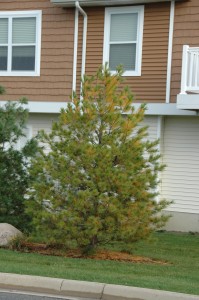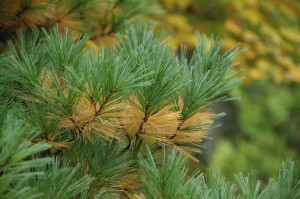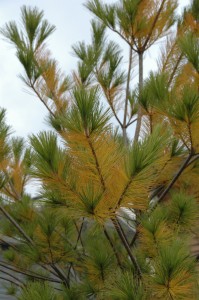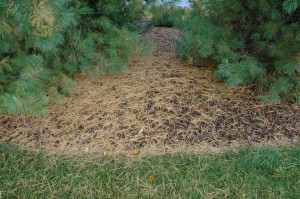Every once in a while in this line of work we’re actually able to give a homeowner some good news about their trees. A case in point is a call that we frequently get this time of year that starts like this: “My pine tree looks like it’s dying! It’s dropping all of its needles!” If the caller has access to the internet and a digital camera I usually request that the send me a couple of photos; if not, I ask them whether the tree is shedding needles along the outermost part of the limbs or on the interior.

In the vast majority of cases the tree is an eastern white pine (Pinus strobus) and the homeowner is observing is normal needle shed. White pine needles often persist for only two growing seasons. So in the fall they begin to shed their previous-years needles, which often turn an eye-grabbing bright yellow in the process. Actually all pines and evergreen conifers shed their needles; it’s just more noticeable in white pines because they are common in the landscape and their needles are short-lived.


The lifespan of pine needles varies widely among species. In some species, such as white pine and loblolly pine (Pinus taeda), needles may only persist for two growing seasons. On the other end of the spectrum is bristlecone pine (Pinus longaeva), which can retain needles for up to 40 years. For the most part, needle retention is correlated with shoot growth rate; trees with fast growth rates have fast needle turnover, while slower growing trees have long needle longevity. Of course there are lots of exceptions to this trend and environmental conditions can impact needle life-span as well. For example, needles may shed prematurely during a drought.

Bottom-line: If it’s fall and your pine is starting to drop interior needles, chances are it’s normal needlefall and nothing to worry about.

References
Ewers, F.W. and R. Schmid. 1981. Longevity of Needle Fascicles of Pinus longaeva (Bristlecone Pine) and Other North American Pines. Oecologia 51:107-115
Hennessey,T.C. , P.M. Dougherty, B.M. Cregg, and R.F. Wittwer. 1992. Annual variation in needle-fall of a loblolly pine stand in relation to climate and stand density. Forest Ecology and Management. 51:329-338.
Schoettle, A.W. 1990. The interaction between leaf longevity and shoot growth and foliar biomass per shoot in Pinus contorta at two elevations Tree Physiology 7:209-214.
On the west coast we often have the same questions about western redcedar (Thuja plicata).
I’m glad to see this. I moved to Seattle this summer and am seeing needles changing color on the western red cedar mentioned by Ryan in the comment above. I’ll probably still ask someone about it, since where they’re changing is an area that was previously ‘buried’ in an English Laurel that I cut back and it’s not happening anywhere else. But it’s interesting to learn that all of them do this.
My sister was strongly advised by her last employer never to use Facebook. She needs this information. How can your blogs be emailed?
This isn’t a Facebook site. She (or you) can subscribe to it using the “Subscribe” feature in the upper right hand corner of the blog.
White Pine is also a brittle wood, and shedding 1/3 or so of its needles decreases surface area..thus it’s able to ‘shed’ snow and not carry as much of a load. It’s one of natures ways of protecting the branches from snapping.
Eastern white pine are not particularly adapted to shed snow and ice. In fact, they are often one of the most heavily damaged trees during winter storms http://blogs.extension.org/gardenprofessors/2013/12/30/the-ice-pocalypse-of-2013-winners-and-losers/
Variation in needle turnover in pines is thought to be associated with growth rate and nutrient conservation. i.e., needle turnover is slower for species adapted to nutrient-limited sites and that have relatively slow growth rates.
Do new needles ever grow where the old ones fell off? Or does the tree have increasingly long empty branches in the interior? (There aren’t any pines near me to observe.)
Most conifers, including pines, will not form needles on old wood. Yews are one of the few exceptions to this trend.
Actually one exception to this is Canary Island Pine which can sprout needles and even new branches from very old wood on old bark, even down to the base of the trunk. Like Big Cone Douglas fir, they will also sprout from the trunk and branches if ravaged by fire
Interesting info Kevin. Some other pines will re-sprout when young but lose the ability when mature.
I rake up all the white pine needles I can on the lawn and re-distribute them under the pines and throughout the shade garden. I think they look beautiful. Can someone comment on the pros/cons of using pine needles as mulch? Are they too soil-acidifying for many herbaceous plants over time?
Hi Julie:
It’s hard to argue with free mulch! I used to do the same when I lived in South Carolina and our house was in a development that had a lot of slash pine trees. I agree it makes a nice looking mulch. Pine straw mulch can reduce soil pH, however. In one vegetable (okra) production study, pine straw reduced pH by about 0.5 pH units. Whether this is good or bad depends on what you’re growing and your starting soil pH. I would probably give your bedding plants the final say. Pine straw is a predominant landscape mulch (if not THE predominant landscape mulch in the South) and many plants seem to thrive in it.
Okay. This saved me a trip to Extension to look this up. Will share on my local blogs.
Every year I try and take photos of fall needle drop so I’ll have them to explain when someone asks about why the needles are yellow in the fall (example: https://www.flickr.com/search/?tags=fallneedledrop&sort=relevance&user_id=38395710%40N07) Is there a Garden Professors Flickr group? It might be interesting to join and exchange photos of fall needle drop on different pines (among other things).
Hi Karen we don’t but it’s an excellent idea!
Is the same true for spruce trees? We have Black Hills , and Colorado Spruce. We live in Minnesota.Needl es are browning from the interior.
Hi Carolyn:
Spruce drop their needles eventually but needles usually persist 5 or 6 years so their normal needle loss is not as dramatic as in white pine. If you are experiencing extensive needle drop on a spruce, it could be a needlecast disease. There are a couple of keys to diagnosing needlecast in spruce. 1) Current-year (outermost) needles are unaffected. 2) Older (interior) needles have black dots that appear under a hand lens (see link below). These dots are actually the fruiting body of the needlecast fungi. Treatment is possible for needlecasts but proper timing is essential and will require professional spray equipment to get good coverage on large trees.
http://www.extension.umn.edu/garden/yard-garden/trees-shrubs/spruce-tree-diseases/rhizosphaera-needle-cast/index.html
It’s been a cold winter. My evergreens are dropping needles/ branches. It looks different than normal needle drop because the needles are green and the branches are about 6+ inches long. Is anyone else experiencing this? Could they have a disease?
Hi Diane:
Will need a little more info to sort out your issue. Do you know what type of evergreen? Pine? Spruce? Something else? Where are the trees?
The type of needle-shed described in this article happens to pine in the fall. If you’re seeing needle loss now if could be some type of winter injury. We talked about winter burn on conifers last winter http://blogs.extension.org/gardenprofessors/2014/04/14/feel-the-burn/ If you are east of the Rockies I expect we will see similar damage from this winter’s severe weather as well.
If you have access to a digital camera, you are welcome to send photos to my e-mail: cregg@msu.edu. If you send photos try to send a close up of the damage and also a longer shot of the tree(s) and the site.
Help! I have already lost one and the other 3 are in rapid decline or critical condition! Starts with brown spots and white stuff at base then are dead in 3-4 weeks. What can I do to save them?
Without more info we can’t help. Sorry.